If you’re finding it difficult to attract top talent, the issue might be that you don’t know how to write an attractive job advertisement. Maybe all the elements are there: a good salary, great benefits, and unique growth opportunities. However, you might not be ‘selling’ it in a way that encourages applications.
It might also just be that the talent pool seems to be getting shallower by the day, and the best people are already working for someone else. So, where do you start?
Consider taking a closer look at your first point of contact with the applicants—your job ad! Use these tips to learn how to write a job posting that will attract quality candidates.
TL;DR — Key Takeaways
- Learning how to make a job post more appealing brings in better applicants, lowers turnover and attrition, helps you hire more quickly, and leads to a lower cost per hire.
- An attractive job advertisement sells the job by drawing quality candidates in to explore and apply. Well-crafted job descriptions are the first pre-screening step, ensuring job seekers understand key job requirements and can self-qualify.
- Some of the best ideas on how to make a job posting more appealing include disclosing the salary, keeping your requirements list short and to the point, paying attention to formatting and design as well, and sticking to a recognizable job title (but we’ve got more tips below!).
- One simple way to jazz up your job postings to attract quality talent is to gamify your application process. With recruiting software like Toggl Hire, you can use a quiz-like skill test instead of a CV and a cover letter to entice talented (yet passive) candidates to look at your ad and apply. It works like a charm!
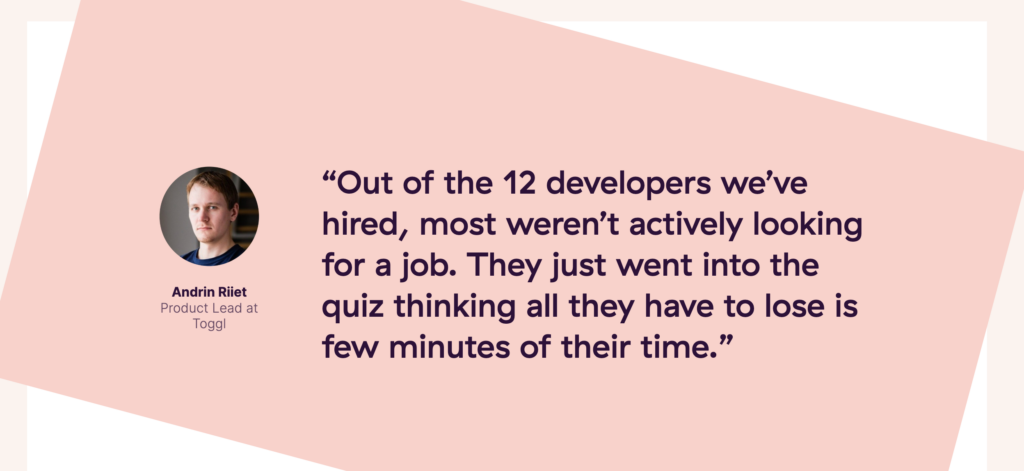
What is a job ad?
A job ad is typically how a company announces they’re looking for someone to fill a new vacancy. Good job postings are clear on the role and responsibilities and also show candidates why they should want to work at the company.
Here’s a great example to help you understand the importance of a good job advertisement: A concert poster generates excitement about an upcoming show, making fans flock to buy tickets. A well-written job advertisement achieves a similar result — grabs candidates’ attention and entices them to apply.
If drawing those candidates in is the first challenge, though, then encouraging the right type of candidates to apply is the second, which brings us to the next question…
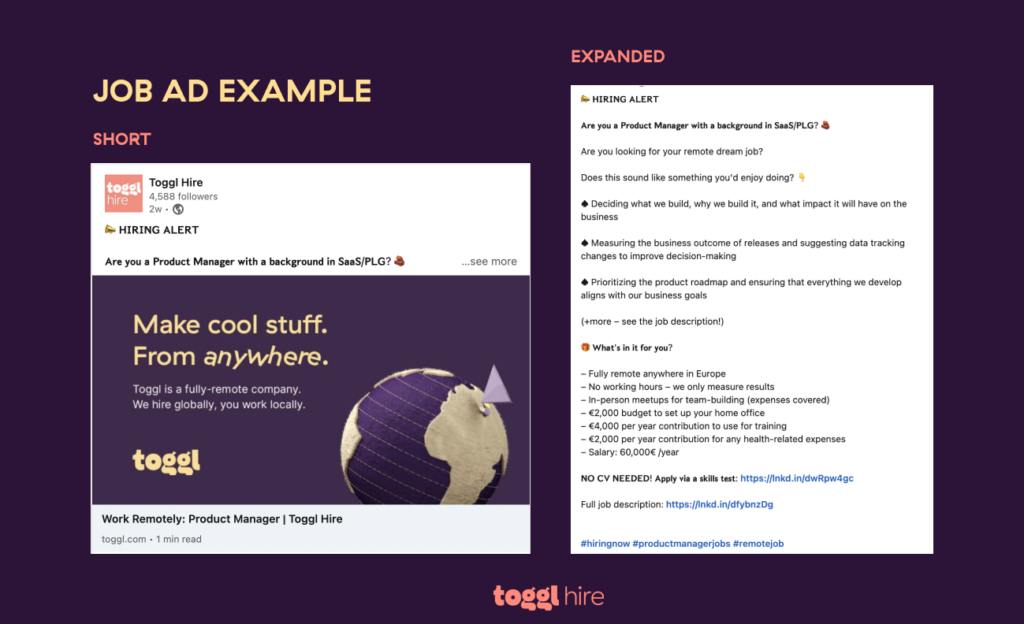
Why is it important to have compelling job ads?
Think of it this way: You want people to apply.
However, getting too many unqualified applicants puts you at risk of wasting precious hours of your hiring team sifting through an endless pile of irrelevant CVs. Too few, and you may struggle to find the right candidate and have to settle for the second (or third) best.
That, and a multitude of other reasons why you need a high-quality, attractive job ad, include:
- Better quality (and quantity) of applicants
- Shorter time to fill and time to hire
- Lower attrition
- Improved candidate experience
- Lower cost per hire
- Better offer acceptance rate
- And many more!
A strong job ad won’t fix a broken hiring process, but it can certainly help to create demand among the best kind of interested candidates. Still, you’ll need to ensure the rest of your recruitment process is efficient and engaging for candidates, too. Reducing the time to hire and improving the candidate experience should be core goals across the entire process.
Why isn’t your job ad attracting strong candidates?
We’re sorry to have to break it to you…but it’s probably not them; it’s you. The good news is that it’s likely due to something easily fixable. Let’s take a look at some of the main reasons why your existing job posts might not be working to attract your ideal candidates.
“Post and pray”
Uploading your job posts on various general job boards and praying that people see them is a common mistake. Instead, you need to think beyond job boards and advertise the open role in the places where your ideal candidates are likely to be, like niche industry groups, Slack channels, newsletters, and social media.
You’re only attracting the unemployed…
…which is only a fraction of potential hires. While there’s nothing wrong with being unemployed and actively looking for a job, by not targeting passive candidates, you’re missing out on other talent. In fact, some of the best talents in the market are passive candidates, so you’ll need to create a strategy to get their attention, too.
It’s poorly structured or written
If your job ad reads like a hastily scribbled note on a napkin, don’t be surprised if top talent ‘swipes left.’ A mess of unclear tasks, pie-in-the-sky requirements, and typos screams, “We don’t have our act together!” Remember, you’re not just listing a job; you’re selling a position that someone will spend 40 hours of their week doing. Make it snappy, make it clear, and, for goodness’ sake, spell-check!
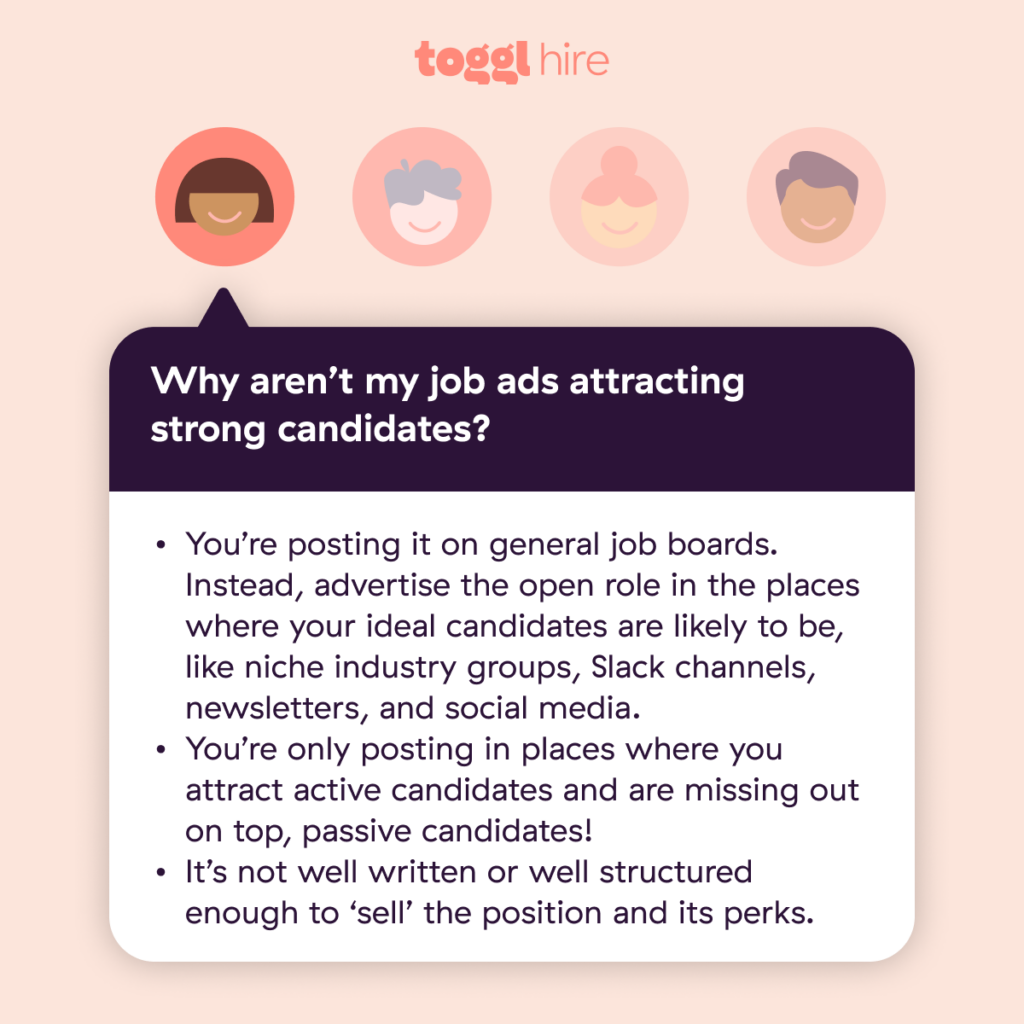
Job ad vs. job description: What’s the difference?
Although sometimes used interchangeably, a job ad or job posting (advertising a new role) isn’t to be confused with a job description (the job details) of that role. They are two separate things, but they need to work together to attract the right candidates.
A great way to distinguish between the two is to consider their purpose: write a job ad to sell the job and a job description to explain the job.
| Comparing | Job Description | Job Posting |
|---|---|---|
| Use | Internal | External |
| Type | Document | Advertisement |
| Purpose | Explain the job | Sell the job |
| Information | Responsibilities, day-to-day | Company, perks, job |
| Tone | Formal | Fun & engaging |
| Length | Longer | Shorter |
6 common mistakes to avoid in job postings
There are some obvious mistakes you can avoid in your job postings to significantly increase your hiring metrics. Here are six of the most common blunders candidates consider as ‘red flags‘ today.
1. Not disclosing the salary
This is a hot topic…but, generally, having a salary range in your job postings will make your job ad stand out on job boards and get more relevant candidates. Plus, it ensures that those who do apply understand the salary and are aligned with what you’re offering.
2. Having a long list of required qualifications
Think of the core competencies a candidate needs for the job and list everything else as optional and nice-to-have to avoid solid candidates from self-selecting themselves.
📚 Not sure how to nail the job requirements for a new vacancy? Read this guide!
3. Too many clichés and fluff
Candidates actively looking for a job read multiple job ads per day (or hour!). You can stand out by using clear and simple language while avoiding clichés—and definitely stay clear of anything involving rockstars, ninjas, and gurus.
Some other examples of job ad red flags include phrases such as:
- We’re a family – translates as ‘office politics and no boundaries’
- You will wear many hats – translates as ‘you’ll do many different jobs, get paid for one’
- Fast-paced, competitive work culture or Work hard, play hard – translates as ‘toxic work environment’
- Competitive salary – translates as ‘your salary will compete with your bills’
To write a punchy job posting, stay away from clichés and fluff as people now read between the lines!
4. No mention of paid time off and sick leave
Make sure to cover both in your job posting, as these benefits are just as important as the salary. If you don’t offer these, first consider why. If you’re not in a position to offer such perks, highlight other benefits your top candidates might expect and enjoy.
5. No explanation of the hiring process
Great job postings walk candidates through the stages of the hiring process so they know what to expect before even applying. Hint: lengthy processes with many stages will put candidates off!
6. Asking candidates to “occasionally” work after hours or during weekends
If you’re advertising for a full-time salaried position of 40 hours, do not set an expectation for candidates to work overtime right from the job postings. If you mention this in the job advertisement, rethink your employment conditions and pay to compensate for those extra hours.
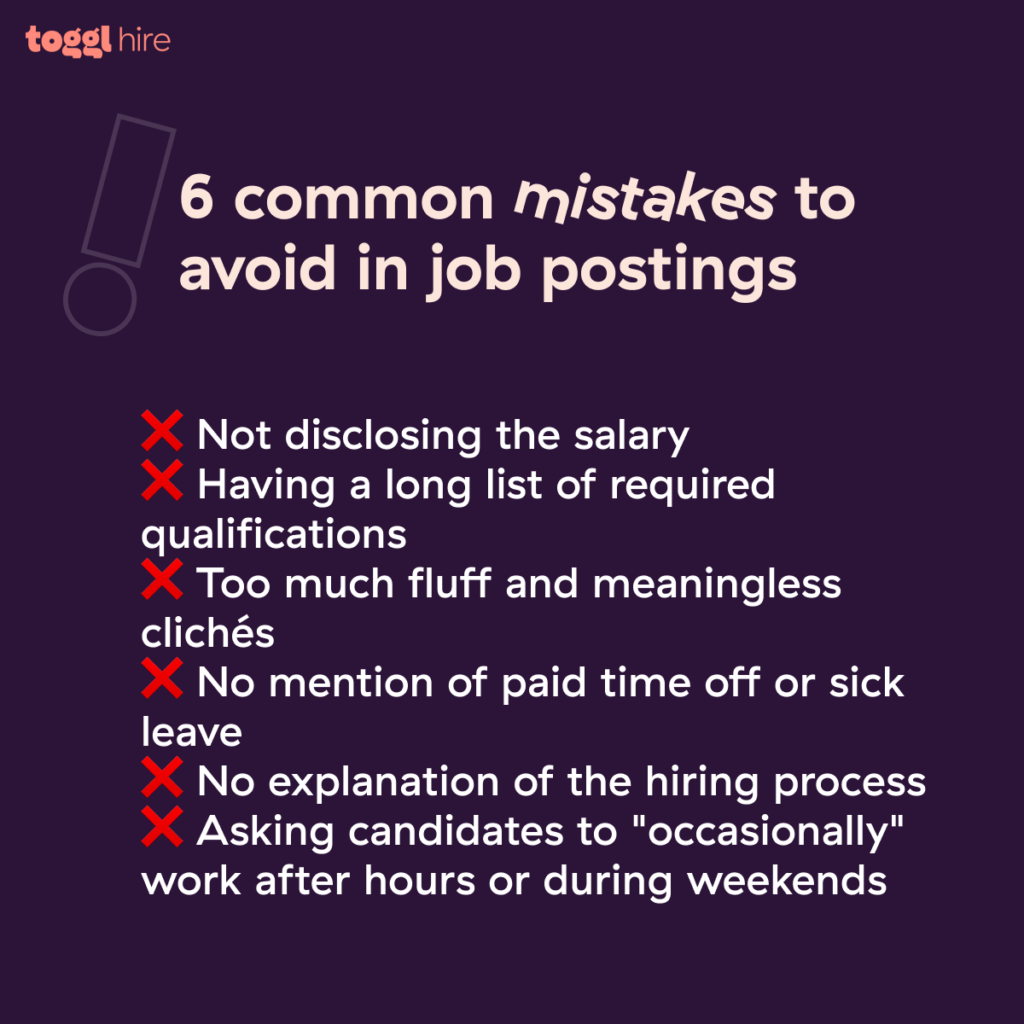
How to improve your job ad?
All of these problems can be solved at the beginning of the hiring process by making attention-grabbing job postings. Here’s how to do it.
1. Write your job description carefully
Top talent can only be attracted to a top job ad. If your ad looks and reads like everything else out there, don’t be surprised if the candidates you attract are average as well.
Being a writer, grammar and syntax are the first things I notice in a job ad. If you’re fishing for top-tier employees, spend a few extra minutes running your job posting and your description through a spell checker.
Additionally, ensure the ad doesn’t look like a huge wall of text. It’s good to be elaborate, but short bullet points are better at grabbing attention.
Short bullet points are better at grabbing attention.
How you speak to people reading your job ad is just as important as your message. Take a look at the Pinterest job ad above. The sentence “You’re a passionate graphic designer…” sounds a lot more personal than “The candidate is a passionate graphic designer.
Always speak to your applicants directly so they can envision themselves doing the job they’re applying for.
Remember, this is a job ad, and you’re trying to sell yourself to the applicant. Show them why working with you is great and that your company will give them immense job satisfaction.
While it’s necessary to list a general job description, the majority of your ad should speak about your company’s core values, mission, the benefits and perks of working with you, and why it’s such a cool place to be.
This sounds like common sense, but it’s also backed by evidence. In a study from the University of Vermont, researchers looked at 56 job ads where 991 respondents applied for work.
The ads were split into two groups:
1) focused on what the employer wants from the candidate
2) focused on what the employer offers relevant candidates (career advancement, work autonomy, etc.).
Companies with ads focusing on the applicant were 3x more likely to get higher-quality applicants. What’s more, those that did apply were a better match.
2. Ensure your job ads use inclusive language
The language in your job ad could reveal a lot about the person you intend to hire. You can attract (or discourage) certain demographics to apply for your various job opportunities by using a specific tone of voice or expressions.
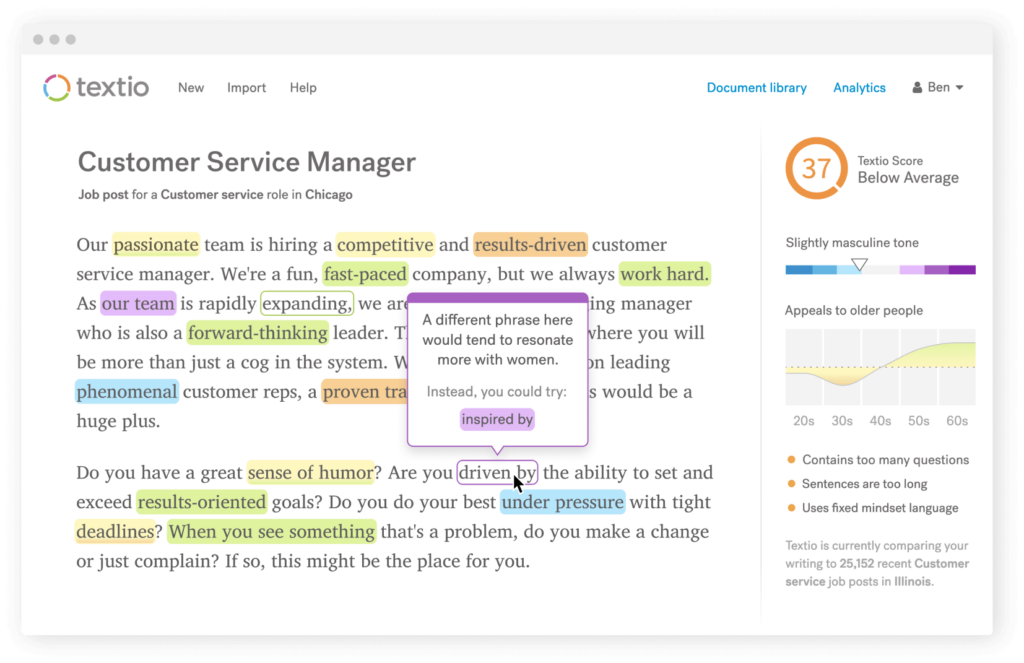
There’s a really neat tool called Textio which was made to help out with job postings copy. It goes through your text and, based on its archive, makes recommendations on how to improve the language to make it less biased.
2. Mind the design
It might seem simple, but visual is one of the most important elements of your job ad. In interesting research done by Software Advice, 51% of respondents claim they would find an ad with images more appealing than one without them.
Okay, but what kind of image do you put in your ad?
For 30% of respondents, they would be most attracted to the company’s products or services. If you’re in IT and you don’t think screenshots and lines of code would be that impressive — think again!
For 22% of applicants, seeing your employees in the image would make a job ad more appealing.
We recently saw a great example of a job ad from Canva. Since they’re a design tool, the job ad was visually stunning (nothing surprising there).
Why did the job ad work well? Here are the key takeaways:
- Great readability, lots of white space
- Forces you to scroll down and finish reading the page
- Plenty of images
- A clear call to action to apply for the job that is sticky on the page
- A separate block to check out the rest of the engineering team
- An entire block to explore the New Zealand office
Of course, not everyone has a team of designers at hand ready to create a beautiful job ad page. However, with services such as Fiverr or Dribbble, there’s no excuse for not having a great job ad design!
3. Be careful about the job title
If you’ve been on LinkedIn for a bit, you probably noticed a trend. There’s an increasing number of quirky job titles, such as ninja, guru, rockstar, and similar.
On the one hand, this has unique value—titles such as growth ninja or HR guru are sure to attract a number of candidates that will click purely out of interest. On the other hand, you’re likely doing yourself a disservice with a creative job title such as this one.
The vast majority of candidates look for jobs through search engines, either on Google, job boards, or free job posting sites like Linkedin and Indeed. So, as boring as it sounds, ‘HR manager’ is a much better solution than ‘HR guru,’ simply because candidates can find it more easily when searching online.
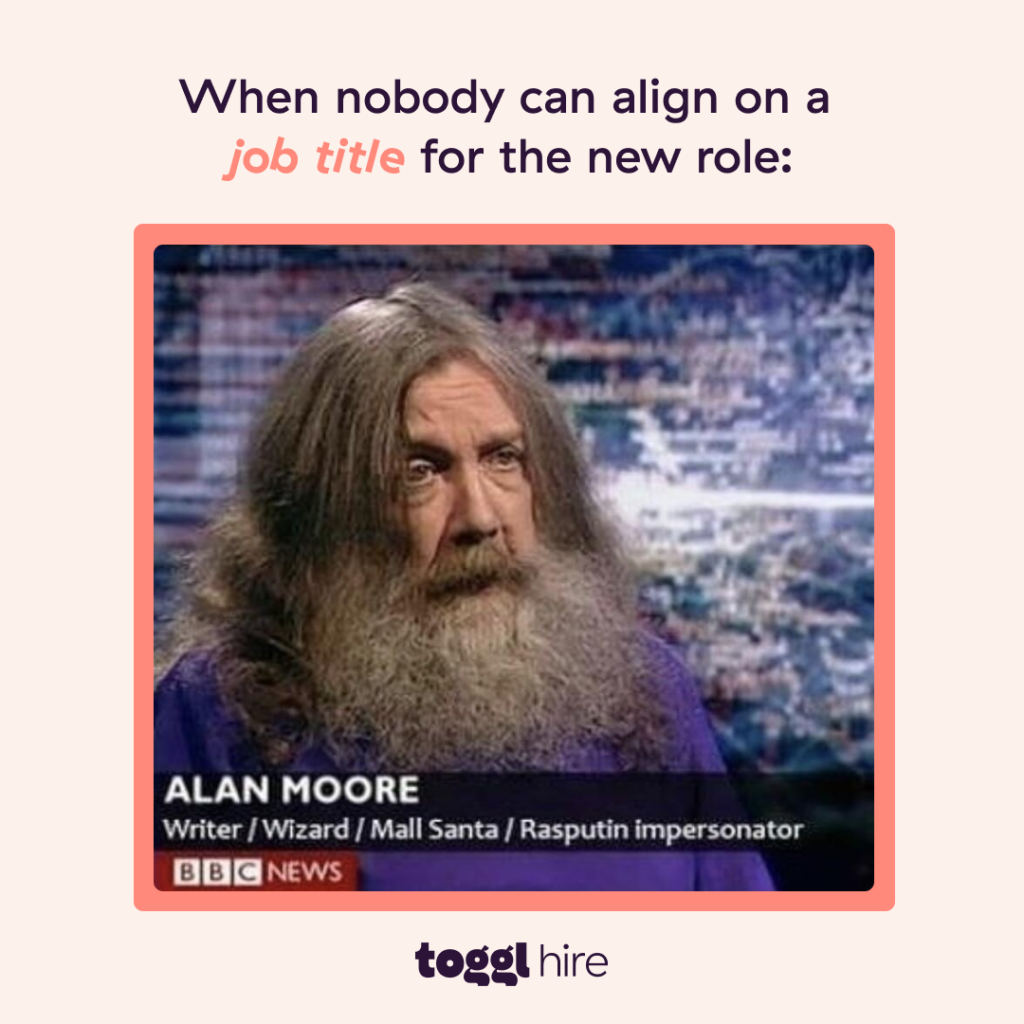
As Paul Petrone of LinkedIn says, your goal should be clarity. If you’re really big on unusual job titles, feel free to use them—after you’ve found your ideal candidate.
Arise App recently advertised for a role titled ‘Mobile App Head of Growth & Monetization (Remote – M/F/D).’ That’s a great example of a job title that is crystal clear. Takeaways:
- Specialization in terms of seniority (head)
- A specific portion of the product (mobile app)
- Clear duties (growth and monetization)
- Clear location (remote)
- Clear applicant gender (M/F/D)
In short, if you’re a candidate intending to apply, this title has everything you need to determine whether this job is a good fit for you.
4. Required vs. good-to-have skills
Obviously, you’re looking for someone who has all the skills to absolutely nail your open position. But when you’re putting together a list of these skills, make sure that you are reasonable.
Many candidates will be put off if the list of required skills is too comprehensive. They’ll be discouraged from applying if they don’t feel like they have everything on your list.
This is why it’s beneficial to separate skills into two groups: required and desirable/good to have, where the essential job skills will be in the first group.
Many candidates won’t apply if the list of required skills in your job ad is too comprehensive.
From the position of a job seeker, this is a good place to find out about the employer’s expectations. For example, if you have an opening for a social media manager and you require active knowledge of CSS and JavaScript, it’s a red flag for the applicant that you don’t really understand what the position entails.
As the creator of the performance-based job description Lou Adler says, the ad should focus on what a candidate can do with what they have, instead of just their skills and experience. Hire the person who can deliver results, not the person with the best skills on paper.
5. Mention the salary
Everyone has bills to pay. Even if your company is a superb place to work with a great culture and a ton of perks, salary matters.
It does not have the same priority for everyone, but the salary is one of the focal points of a good job ad.
The number one reason for listing a salary (or at least a range) is to attract more people. Job ads with a listed salary impact 91% of candidates when deciding whether or not to apply.
What’s more, those who apply know exactly what to hope for. This way, you eliminate anyone who’s too expensive for your budget right off the bat.
91% of job candidates want to see a salary range in the job ad.
LinkedIn
One of the tricks HR managers tend to use in their job postings is listing the salary as ‘depending on experience.’ While it’s a neat way of getting around precise figures, it’s hardly something that will tempt candidates. If you list a range depending on experience, candidates know what to expect, depending on what they bring to the table.
👎 On the other hand, if you don’t list a salary at all, candidates will think you are trying to get an amazing person and pay them very little, according to HR expert Liz Ryan.
Finally, the biggest reason to list the salary in your job ad is to motivate those looking to change jobs.
For over 63% of people who quit jobs, salary is their primary reason for a change in the workplace. If they know that you are offering more, they will be much more likely to envision you as their next employer.
Key takeaways to remember when talking about salary/compensation packages:
- Clearly defined salary range (albeit a wide one)
- A healthy list of benefits, including but not limited to PTO
- A list of all additional benefits
- An offer for a stock purchase plan
In short, you should include everything a candidate needs to determine if a job makes sense financially or not.
6. Offer something for free
This might be considered sneaky, but all is fair if you want to hire your purple squirrel. In fact, this is exactly the trick we’ve used in our quest to hire an SEO manager for Toggl Hire (which was once called Hundred5).
We created a job simulation test using a pre-built SEO assessment template and advertised it on LinkedIn, Twitter, and Facebook. In the ad, we offered a free T-shirt to applicants, but only to those who scored high on the test.
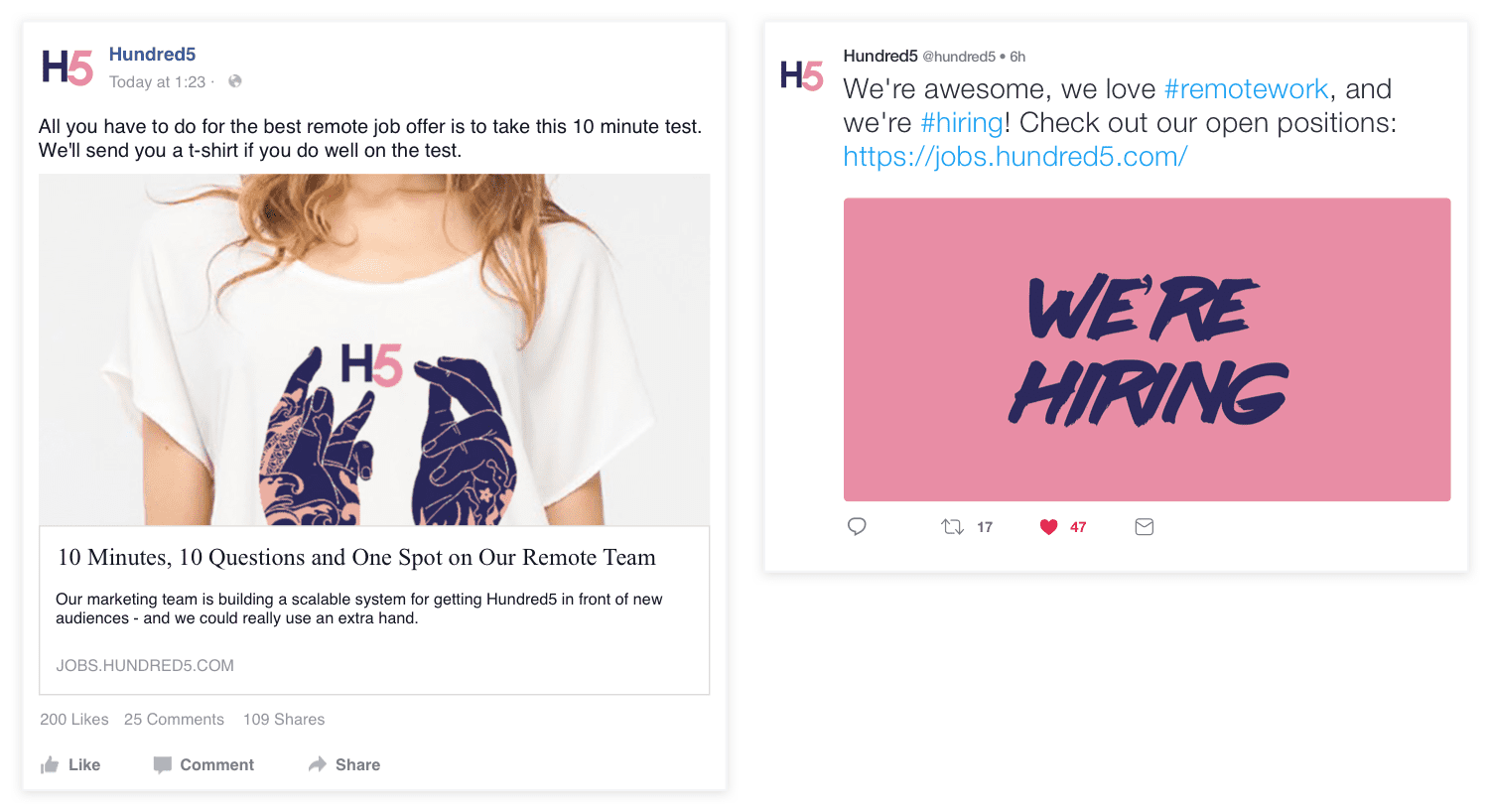
Why did this work so well?
- It’s quirky and innovative, which is likely to attract people who match that line of thinking
- The application barrier is low (it’s just a quiz), and a freebie is an extra incentive to get them interested
- They don’t get the freebie just for participating — they have to complete the test and do it well, so it is a reward rather than a gift
Overall, this tactic helped us get the attention of the passive candidates who would otherwise never check our job opening ads while also boosting our employer brand and showcasing company culture. Win-win!
7. Turn your job ads into skill-screening quizzes
Everything we’ve mentioned so far should lead to massive numbers of applicants for your job postings. While this is a great problem, it’s still a problem.

Especially if you have remote job openings, you’re guaranteed to attract thousands of applicants per job post. Most of them will likely be a poor fit, so you need to disqualify them early on and move on to the candidates who will be a great addition to your team.
That’s exactly what Toggl Hire helps you do.
Combining powerful applicant tracking features with plug-and-play skills assessments, our full-cycle recruitment software helps companies quickly narrow down their application pool to the most qualified people worth interviewing—all while maintaining an excellent candidate experience!
At Toggl, we use Toggl Hire recruitment app to find talented people around the world (yes, including developers!) In fact, all of the openings we have right now are tests on the Toggl Hire platform. Feel free to check them out!
So, what’s so cool about using a skills test in job ads?
- First and foremost, you hire candidates based on performance, not their resumes. You see how they would function in a particular role by giving them a short series of job-specific tasks.
- You also get to hire without bias. You only see the name and results of an applicant.
- Additionally, candidates get their results almost instantly. As soon as they’re done, candidates get an email telling them how well they performed and whether they can expect to go further in the hiring process.
- Finally, and perhaps most importantly, Toggl Hire helps you hire efficiently. The time and money spent on hiring a candidate are cut down significantly compared to the traditional hiring process.
Quick job ad checklist
By now, you’re probably feeling ready to go to a job board or a free job posting site and create an amazing job ad. Before we send you off into the wild alone, here’s a checklist of what to include:
- An accurate job title
- A creative job description
- A transparent salary range and benefits
- A reasonable list of requirements and qualifications
- A step-by-step explanation of the hiring process
- A snapshot of who you are as a company, your values and culture
Do these things right, and every time you post jobs, you can expect a flood of great candidates.
Ready to get started?
Hiring the highest quality candidates starts by making your job ad really stand out from the crowd. However, once they click ‘apply,’ you’ll need to ensure you’re offering a great candidate experience and engaging interview process.
Skills testing and video interviews are a great way to do just that. To continue offering a great candidate experience after the initial job advertisement phase of the recruitment process, take Toggl Hire for a test drive.
Create your free account now to enjoy skills-first full-cycle hiring (yes, it’s a thing).
More questions about how to make job ads more effective
What is an advertisement for a job?
An advertisement for a job is a formal type of announcement where a company informs potential job seekers that they have an opening. The aim of a job ad is to get as many potential candidates to apply.
How do I make a catchy job ad?
The best way to make a job ad that stands out is to talk to the job seekers from their point of view. Think of what would make them apply rather than highlighting your successes as a company. Talk about their duties, the projects they will work on, the company culture, the benefits, and more — rather than focusing on a lengthy list of requirements.
How do you announce a job posting?
There are plenty of free and paid ways to announce and promote your job postings. You should start with the careers page on your website. Then move on to paid and free job posting sites such as LinkedIn, Monster, Remote.co, WeWorkRemotely, ZipRecruiter, and others.
What should a good job ad include?
A good job ad should include a job description that “hooks” the candidate to apply immediately. This means focusing on how they fit into the company from the very start and showing what’s in it for the candidate. It should also include a list of required and “nice-to-have” qualifications so the right candidates don’t get put off and avoid applying.
What are the 5 components of a job description?
The five basic components of every job description are the job title, job description, duties and responsibilities, necessary qualifications, and working conditions.
Mile is a B2B content marketer specializing in HR, martech and data analytics. Ask him about thoughts on reducing hiring bias, the role of AI in modern recruitment, or how to immediately spot red flags in a job ad.




